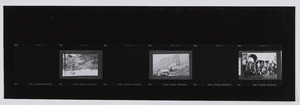Search the Special Collections and Archives Portal
Search Results

Transcript of interview with Amber Allan by David Schwartz, December 21, 2016
Date
Archival Collection
Description
Amber Allan grew up in West Virginia and moved to Las Vegas at the age of 16. She entered the gaming industry in 2000 as a change person at Arizona Charlie’s Boulder where she later held the positions of floorperson and assistant shift manager. Allan would eventually move to Santa Fe Station in 2005 as relief shift manager, later to the Texas Station as a shift manager, and then to Palace Station in 2008 into the slot operations and technical manager role. She then returned to Texas Station at the end of 2008 as director of slot operations and then moved to Aliante Station into the same role in 2009. Allan started at Konami Gaming, Inc. in 2012 where she has worked as an analyst, product specialist, and, currently, as technical sales executive. The interview with Allan begins with her discussion of moving to Las Vegas and the experiences and roles she held as she started in the gaming industry. She discusses the various responsibilities she had in those roles, the types of skills required for them, and the kinds of disputes that are handled in certain supervisory positions. Allan also mentions and discusses the topic of hold percentage as it relates to slot and video poker players. She later describes her philosophy on what makes a good slot floor and also what customers are looking for in slots. Allan then provides the details of her move to the manufacturing side of the slot industry, and she gives her thoughts on what makes both a good and bad slot manager. The interview then shifts to the discussion of free slot play; ticket-in, ticket-out; changes in slot management; and the future of slot machines. The interview concludes with Allan’s discussion of her personal gambling as well as her advice for young people who want to go into the slot industry.
Text
Celesta Lowe oral history interview
Identifier
Abstract
Oral history interview with Celesta Lowe conducted by Patrick W. Canlton on February 06, 2002 for the Boyer Early Las Vegas Oral History Project. Lowe begins by discussing her early life in Baker, California and her father’s role as a station agent for the Tonopah Tidewater Railroad during the 1920s and 1930s. Lowe then describes her family moving to Las Vegas, Nevada in the 1940s. Lowe chronicles the process state legislatures took to open Nevada Southern University in 1957 and her role as an administrative assistant in the main office of the school. Lowe recounts her career at Nevada Southern University, the expansion of the campus, and renaming it University of Nevada, Las Vegas. Lastly, Lowe talks about her switch from an administrative assistant to a librarian at UNLV.
Archival Collection
Larry Ruvo oral history interview
Identifier
Abstract
Oral history interview with Larry Ruvo conducted by David G. Schwartz on January 27, 2009 for the Remembering Jay Sarno Oral History Project. Ruvo begins by discussing his position as a front desk clerk at Caesar’s Palace in Las Vegas, Nevada in the 1970s. Ruvo then describes how Jay Sarno changed the casino industry by designing Caesar’s Palace with a single theme. Ruvo then chronicles how gaming gradually was legalized in more areas throughout the world and how Sarno capitalized on making Caesar’s Palace an iconic casino which made people want to travel to Las Vegas. Lastly, Ruvo discusses Sarno’s focus on offering both gaming and entertainment options for guests at Caesar's Palace.
Archival Collection

Hernando Amaya oral history interview: transcript
Date
Archival Collection
Description
Oral history interview with Hernando Amaya conducted by Laurents Banuelos-Benitez, Marcela Rodriguez-Campo, and Barbara Tabach on October 18, 2018 and December 3, 2018 for the Latinx Voices of Southern Nevada Oral History Project. In this interview, Hernando Amaya talks about his childhood and education in Bogota, Colombia. He discusses his start in journalism as a young man and working for El Espectador, the Colombian national newspaper. He discusses his experiences reporting on the narco-terrorism occurring in Medellin, Colombia and how this eventually led to his immigration to the United States. Amaya moved to Las Vegas, Nevada in 2001 and continued his career in journalism by working for local Spanish speaking papers and websites. He relates his civic involvement in the Las Vegas area, his work as the president of the Colombian Association of Las Vegas, and various other civic engagements. As a journalist, he asserts the importance of knowing one's culture, storytelling, learning history, and being active in the community.
Text

Film strip of individuals or Hoover Dam construction, image 012: photographic print
Date
Archival Collection
Description
Image
Apolonio Sauceda Scrapbooks
Identifier
Abstract
The Apolonio Sauceda Scrapbooks (1973-2010) document Apolonio "Loney" Sauceda's acting career and his work with the Nevada Association for Latin Americans (NALA) in Las Vegas, Nevada. Two scrapbooks document Sauceda's career as an actor and contain photographs of Sauceda on set, at premieres, with other actors, and depict movie sets at well-known Las Vegas hotels and casinos in the 1980s and 1990s. Newspaper clippings accompany many of the photographs and provide details about locations, major actors, or the producers for each film. The third scrapbook is compiled of newspaper clippings that document the local Las Vegas, Nevada Latinx community and NALA events in the 1970s, ranging from political activism, labor strikes, beauty pageants, and religious gatherings.
Archival Collection
George Kelly Ryan Papers
Identifier
Abstract
The George Kelly Ryan papers (1921-1971) contain correspondence inquiring about Octavius Decatur "O. D." Gass, newspaper clippings from 1929, handwritten recollections of the Gold Ranch by Laura Royce, and a San Pedro, Los Angeles and Salt Lake Railroad Company information, including information on wash-outs in Nevada.
Archival Collection
Las Vegas-Clark County Library District Records
Identifier
Abstract
Collection is comprised of materials dating from approximately 1971 to 1996 about the Las Vegas Clark County Library District. Collection materials also include Charles Hunsberger's subject files from when he was library director of LVCCLD. The collection includes annual financial reports, clippings about the library district, photographs, master plan documents for Nevada libraries, and staff newsletters. In addition, the collection also includes materials documenting Hunsberger's efforts to secure a $22.2 million library bond in 1985.
Archival Collection
George Kelly Ryan Photograph Collection
Identifier
Abstract
The George Kelly Ryan Photograph Collection (1929) depicts waterways in Southern Nevada and Northern Arizona. The collection consists of eight photographic prints and two photographic negatives depicting Saint Thomas, Black Canyon, Boulder Canyon, and the Colorado River.
Archival Collection

